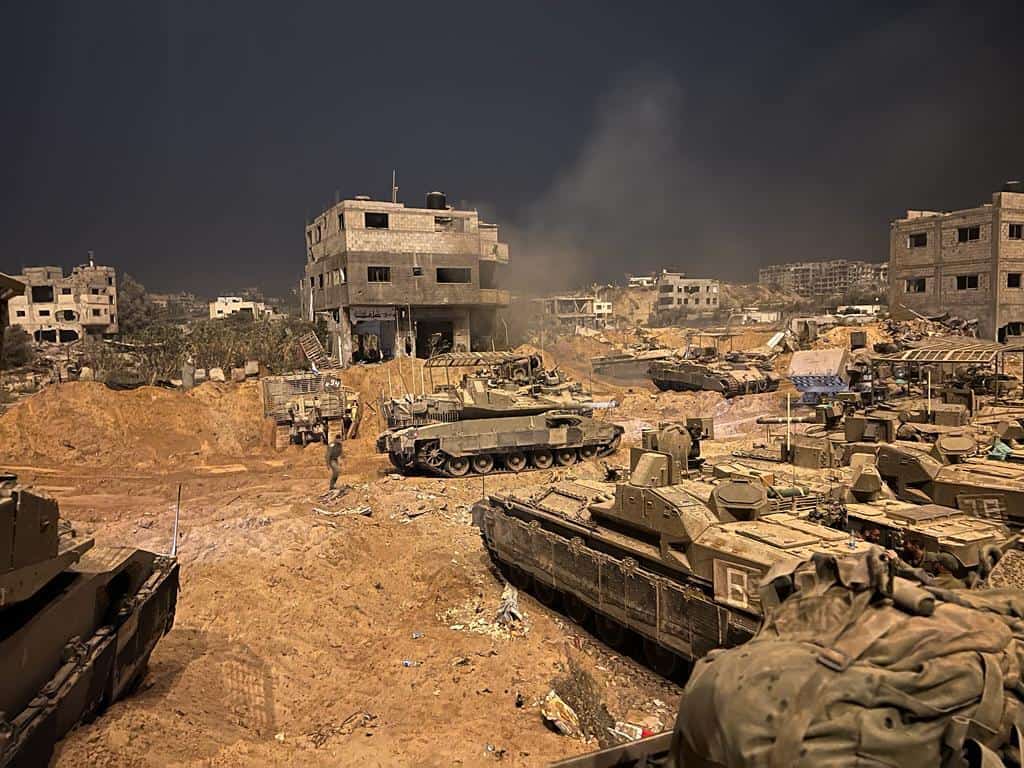
Seth Frantzman is reporting from Israel.
Israel’s operations in Gaza may be reaching a turning point as units press close to Gaza City. At the same time, Hezbollah’s Hassan Nasrallah is scheduled to give a speech on Friday, while the Iran-backed Houthis in Yemen continue to make threats against Israel. This creates a regional alignment in which Iran may use the conflict in Gaza to push for more escalation from Lebanon or other fronts. Israeli security officials stressed on Thursday that Israel is prepared to fight on multiple fronts and ready for different scenarios.
IDF Chief of the General Staff, Lt. General Herzi Halevi, said on Thursday that IDF troops in Gaza had “advanced to another significant step and IDF troops are now engaged in a ground operation in the northern Gaza Strip. For the last few days, IDF soldiers have been operating in Gaza City and are encircling it from several directions.” The exact extent of IDF operations continue to be clouded in operational security, but the reference to encircling the city would point to forces operating in the narrow waist of the central Gaza Strip, between Gaza City and the southern Gaza Strip. Reports earlier this week pointed to a three-pronged ground offensive, one along the shore, one in the northeast of the strip, and one in the center. It remains to be seen how this will develop as calls grow for a ceasefire or temporary humanitarian pause in fighting.
The IDF says it eliminated 130 members of Hamas in fighting over the last 24 hours and that Hamas’s defensive lines have collapsed. “We continue to intensify the activity and move forward according to the plan and goals we have set for ourselves. We operate according to the plan in every battle we have the upper hand. The extensive logistical effort continues even now – ammunition and protective equipment continue to constantly flow to our fighters on the battlefield,” said IDF spokesperson Rear Admiral Daniel Hagari.
He also emphasized that in the north, Israel continued to respond to Hezbollah attacks. This included Hezbollah’s use of rockets, anti-tank missiles and mortars. Hezbollah also launched a surface-to-air missile against an Israeli drone, and a Wall Street Journal report said Hezbollah sought to acquire an SA-22 Pantsir system from the Russian Wagner group. The Pantsir uses 30mm cannons and missiles to intercept aerial threats. It was used in Libya and Syria. A large system like the Pantsir, transported by an 8 by 8 truck, stands out on the battlefield.
The IDF stressed that it is “highly prepared to respond strongly to anyone who tries to undermine the security situation in the north.” Chief of Staff Halevi made similar comments about the IDF’s strength and posture in the north. Israel’s Minister of Defense also emphasized, in a discussion with combat engineers, that Israel has unique methods of targeting Hamas in tunnels. He noted that Hamas members would meet the same deadly fate underground as aboveground.
Israel continued to suffer casualties on Day 27 of the war. Some 335 IDF soldiers have died in battle since Oct. 7’s surprise Hamas attack. Lt. Col. Salman Habaka, a commander in the 53rd Battalion of the 188th armored brigade, was killed in Gaza. He was remembered as a hero for his role on Oct. 7 when he rushed south to join the fighting and led a tank into Kibbutz Beeri to help stop the terrorist attack. A member of Israel’s Druze minority, his heroism and subsequent death in Gaza was widely remembered as a symbol of conflict. On Thursday, the IDF also updated the number of people abducted and held in Gaza, which now stands at 242. Four have been released, while one soldier who was abducted was rescued this week.
In addition, the Ministry of Defense gave a briefing on Thursday detailing its plans for procurement for the next months of fighting. It has set aside significant sums for acquiring everything from new shelters to ceramic plates for soldiers to buying food for the army, and also purchasing or leasing cars, trucks, busses, and other vehicles needed as part of the logistical tail of the army. This also included 100 flights of cargo planes to Israel over the last month to bring in needed equipment and munitions.
While Israel is prioritizing local factories, and actively employing 57,000 people in hundreds of businesses, according to the Ministry, it is also acquiring what it needs abroad. Israel is investing in necessary technologies that exist, such as counter-drone systems, in the wake of Hamas’s small commercial drone approach from Oct. 7. Thursday’s presentation by the Ministry painted a picture of preparations for a long war ahead and what they said was 24/7 work to move the necessary items, from uniforms to tomatoes, to the frontline.
Israel also said on Thursday that it had used an F-35 Adir to down a cruise missile fired from Yemen. While this potential capability has been known for several years, this was the first time that Israel had referenced an interception of this kind using the F-35.







